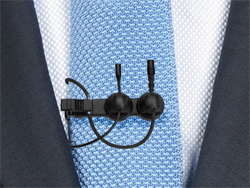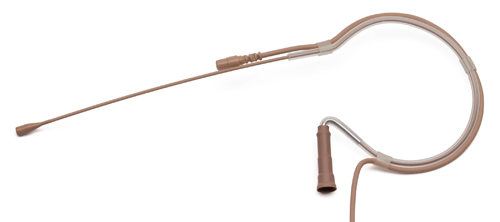
At The Ear
A miniature lavalier mic can also be run along the boom of an omnidirectional earset mic to provide a live back-up option. To secure the lavalier to the earset, use clear heat shrink tubing or small pieces of clear tape at several points along the ear loop and boom.
Attach the cables of both mics together as well, making sure to provide sufficient slack to allow the user to turn his head from side to side.
Functionally, the ideal placement is for both mic capsules to be right next to each other. This way, if the sound engineer needs to switch from the earset to the lav, the audience will not perceive a difference in the background sound level.
However, it means that the mic footprint in front of the face is twice as large as it needs to be. One possible solution is to use a hypercardioid lavalier as the back-up mic, and pull it back closer to the ear.
The hypercardioid back-up should still be as small as possible so that it does not look like a protrusion or mole on the cheek.
With this tiny lav pulled away from the mouth, it will barely be visible. And, with the hypercardioid pattern, if you do need to switch to the back-up, the background noise will still be comparable to the omni earset mic placed directly at the mouth.
Peace Of Mind
The best “back-up” is making sure you invest in quality products in the first place. They should be built to endure moisture and rough-handling. For example, the mic cable should be reinforced with Kevlar or Aramid strength members so that it doesn’t break if someone accidentally tugs on it. The mic diaphragm and electronics should be sealed from moisture to avoid any possibility of being “sweated out.”
Fortunately, this does not mean that the mic must be large – even the world’s smallest mics can be designed to withstand this type of treatment. However, it does mean that the cheapest mic is usually not the right choice. When sitting behind a mixing console for a production with a live audience and perhaps a broadcast feed, you’ve got enough to worry about – why not enjoy peace of mind?
And, as you then begin to wonder what would happen if something does go wrong with “plan A,” you’ll find comfort in knowing what no one else knows– your discreet “plan B” is just as good.
Omer Inan is chief engineer at Countryman Associates. He received his BS, MS, and PhD in Electrical Engineering from Stanford University.

